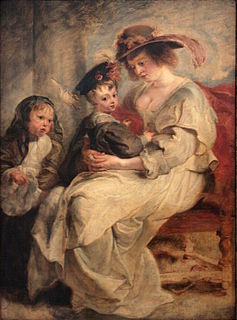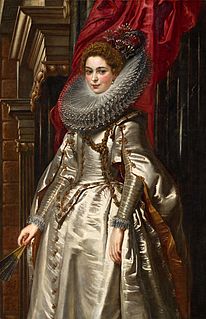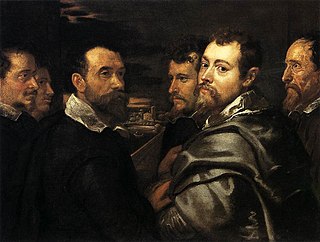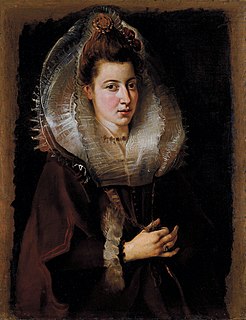 W
WPortrait of Giovanni Carlo Doria on horseback is a 1606 painting by Peter Paul Rubens. It shows its subject aged 30. It is now held in the Galleria Nazionale di Palazzo Spinola in Genoa - it was moved to Naples in 1940 and acquired by Adolf Hitler on the suggestion of Benito Mussolini, before being returned to Italy at the end of World War Two.
 W
WEquestrian Portrait of the Duke of Lerma is a 1603 portrait of Francisco Gómez de Sandoval, 1st Duke of Lerma by Rubens, now in the Prado in Madrid.
 W
WThe Four Philosophers is a 1611-12 painting by Peter Paul Rubens. It is now held in the Galleria Palatina of the Palazzo Pitti in Florence. It also features in the 1772 painting The Tribuna of the Uffizi by Zoffany.
 W
WHelena Fourment with a carriage is a 1639 painting by Peter Paul Rubens, showing his second wife Helena Fourment, their son Frans and a carriage.
 W
WHelena Fourment with Children is a c.1636 painting by Peter Paul Rubens, showing his second wife Helena Fourment with their son Frans in her arms and their daughter Clara Johanna standing to their left. It was acquired by Louis XVI of France in 1784 and is now in the Louvre Museum in Paris.
 W
WHelena Fourment with her son Frans is a c.1635 painting by Peter Paul Rubens, showing his second wife Helena Fourment holding their second son Frans. As of 2014, it is in the Alte Pinakothek in Munich.
 W
WThe Honeysuckle Bower is a self-portrait of the Flemish Baroque painter Peter Paul Rubens and his first wife Isabella Brant. They wed on 3 October 1609, in St. Michael's Abbey, Antwerp, shortly after he had returned to the city after eight years in Italy.
 W
WThe Portrait of Infanta Isabella Clara Eugenia is a painting by Rubens of Isabella Clara Eugenia. It is dated to 1625 and shows her in the habit of the Poor Clares, which she assumed on 22 October 1621 after the death of her husband Archduke Albert of Austria. She visited the painter's studio while on her way back from Breda in 1625 to see the painting begun, as a master copy from which several others could be drawn. The master copy is now in the Galleria Palatina in Florence, having been traded in the past for a portrait of the same subject by Anthony van Dyck. Two other copies are known in private collections, while a third is in the Norton Simon Museum in Pasadena.
 W
WPortrait of Susanna Lunden or Le Chapeau de Paille is a painting by Peter Paul Rubens, in the National Gallery, London. It was probably painted around 1622–1625.
 W
WThe Portrait of Marchesa Brigida Spinola-Doria is an oil-on-canvas painting by Flemish artist Sir Peter Paul Rubens, dating to 1606. It is now in the National Gallery of Art in Washington, D.C., part of the Samuel H. Kress Collection. It was commissioned by Marchese Giacomo Massimiliano Doria of Genoa and shows his wife shortly after their wedding in 1605; she came from the equally prominent Spinola family. He died in 1613 and she remarried another Doria. It has been trimmed several times on each side, removing the garden shown in the background and the lower part of the figure.
 W
WPortrait of a Commander or A Commander Being Dressed for Battle is a portrait of an unknown man in plate armour, normally attributed to Peter Paul Rubens. In July 2010 it was sold for £9 million by Christie's after Sotheby's turned it down, suspecting its authenticity as a Rubens. In December 2011, the portrait was placed on loan with the Metropolitan Museum of Art in New York.
 W
WPortrait of a noblewoman with a dwarf is a c.1606 portrait by Peter Paul Rubens. It probably shows Maria Grimaldi, daughter of Carlo Grimaldi, a marquess who in 1607 loaned his villa at Sampadierna to Rubens and his patron Vincenzo Gonzaga, Duke of Mantua. The painting is now owned by the National Trust, as part of their Kingston Lacy property.
 W
WThe Self-portrait is an oil on canvas by Rubens measuring 109.5 cm by 85 cm and dating to between 1638 and 1639. It is now in the Kunsthistorisches Museum in Vienna. It is a courtly portrait in style, but shows more attention to facial detail than was usual in a portrait of that kind.
 W
WSelf-Portrait is a 1623-1630 self-portrait by Peter Paul Rubens. Since 1972 it has hung in the Rubenshuis in Antwerp.
 W
WSelf-Portrait is a 1623 self-portrait in oils on canvas by Peter Paul Rubens, signed and dated by the artist. He produced it to send to Charles Prince of Wales and it is still in the Royal Collection.
 W
WSelf-portrait in a circle of friends from Mantua is an oil on canvas by Peter Paul Rubens, produced between 1602 and 1605. It measures 77.5 cm by 101 cm. It is now in the Wallraf-Richartz Museum in Cologne. From left to right it shows Frans Pourbus, Caspar Schoppe, William Richardot, the painter's brother Philip or Filippo Rubens, Rubens himself, and Justus Lipsius.
 W
WThe "lost portrait" of George Villiers, 1st Duke of Buckingham is a portrait, painted around 1625 by Flemish artist Peter Paul Rubens, of George Villiers, 1st Duke of Buckingham.
 W
WPortrait of a Young Woman is an unfinished painting of around 1603, attributed to Rubens. It may be connected with a commission from Vincenzo Gonzaga, Duke of Mantua mentioned in Rubens' letters, during the latter's time in Italy and Spain, to paint aristocratic Spanish ladies to add to the duke's 'gallery of beauties'. Its subject's name is unknown. Two red seals on its back place it in Venice early in the 19th century and then in the collection of Sir John Hanmer at Bettisfield Park in Wrexham by the 1840s.